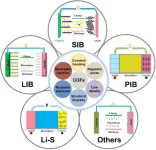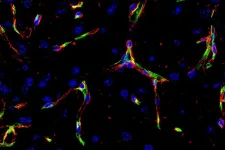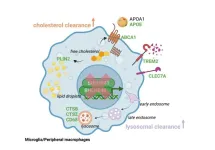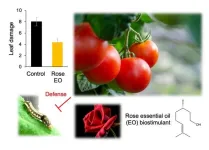In-situ observation of nanoscale heat propagation
New electron microscopy technique developed for thermal diffusion measurements
2024-03-21
(Press-News.org)
1. A NIMS research team has developed a technique that enables the nanoscale observation of heat propagation paths and behavior within material specimens. This was achieved using a scanning transmission electron microscope (STEM) capable of emitting a pulsed electron beam and a nanosized thermocouple—a high-precision temperature measurement device developed by NIMS.
2. Public interest in energy conservation and recycling has grown considerably in recent years. This change has inspired scientists to develop next-generation materials/devices capable of controlling and utilizing heat with a high degree of precision, including thermoelectric devices able to convert waste heat into electricity and heat dissipation composites that can cool electronic components exposed to high temperatures. It has been difficult to measure nanoscale heat propagation within materials because its characteristics (i.e., the amplitudes, velocities, paths and propagation mechanisms of traveling thermal waves) vary depending on the characteristics of a material (i.e., its composition and size and the types and abundance of defects within it) to which heat is applied. The development of new techniques enabling in-situ observation of how heat flows through the nanostructures of materials had therefore been anticipated.
3. This research team developed a nanoscale heat propagation observation technique using a STEM in which a pulsed nanosized electron beam is applied to a specific site of a material specimen, generating heat which is then measured in the form of changing temperatures using a nanosized thermocouple developed by NIMS. Irradiating the specimen with a pulsed electron beam enables the periodic measurement of different thermal wave phases and the analysis of thermal wave velocities and amplitudes. In addition, precise nanoscale repositioning of irradiation sites enables the imaging of temporal changes in thermal wave phases and amplitudes. These images can be used not only to perform nanoscale thermal conductivity measurements but also to create an animated video tracking heat propagation.
4. The complex relationships between the microstructures of materials and how heat flows through them may be elucidated by observing nanoscale heat propagation using the in-situ technique developed in this project. The technique may allow the investigation of complex thermal conduction mechanisms within heat dissipation composites, evaluation of interfacial thermal conduction within micro welded joints and in-situ observation of thermal behavior within thermoelectric materials. This may contribute to the development of high-performance, high-efficiency, next-generation thermal transport materials and thermoelectric materials/devices.
***
5. This research was published in Science Advances (vol. 10, issue 2) on January 13, 2024, Japan Time.
END
ELSE PRESS RELEASES FROM THIS DATE:
2024-03-21
They published their work on Mar. 15th in Energy Material Advances.
"It is highly necessary to design highly conductive and high-performance materials for application in alkaline ion batteries," said paper author Xijun Xu, associate Professor at the College of Chemical Engineering and Light Industry, Guangdong University of Technology.
"In recent years, with the development of large-scale power systems such as electric vehicles, the demand for secondary batteries has gradually shifted towards high power and low cost. Furthermore, in light of the increasing energy and environmental concerns, the exploration of green and renewable ...
2024-03-21
They published their work on Mar. 15th in Energy Material Advances.
"The development of cost-effective and high-performance RP anode materials for LIBs/SIBs is imperative," said paper author Hailei Zhao, professor with the Beijing Key Lab of New Energy Materials and Technology, School of Materials Science and Engineering, University of Science and Technology Beijing, "Despite RP shows a great potential, the inherent poor electrical conductivity of RP (~10-14 S cm-1) and significant volume changes during charge/discharge processes (> 300%) compromise its cycling stability."
Zhao explained that the poor electrical conductivity ...
2024-03-21
In a Finnish outcrop nestled between some of Northern Europe's oldest mountains, researchers have found traces of a previously hidden part of Earth's crust that points more than three billion years back in time and north towards Greenland.
These traces were found in the mineral zircon, which after chemical analyses, indicated to researchers from the Department of Geosciences and Natural Resource Management that the "foundation" upon which Denmark and Scandinavia rest, was probably 'born' from Greenland approximately 3.75 billion years ago.
"Our data suggest that the oldest part of Earth's crust beneath Scandinavia originates ...
2024-03-21
Among the many confounding symptoms in patients recovering from a COVID-19 infection are memory loss and difficulty learning. Yet little is known about the mechanisms of cognitive impairments like these, commonly called brain fog.
In a new study, researchers at the University of Illinois Chicago have identified a mechanism that causes neurological problems in mice infected with SARS-CoV-2, the virus behind COVID-19. The researchers also found a treatment that helped prevent these changes. Sarah Lutz, assistant professor of anatomy and cell biology in the College of Medicine, led the research, ...
2024-03-21
Highlights:
Legionnaires’ disease is a rare and dangerous respiratory tract infection.
Diagnoses and surveillance usually require culturing isolates.
A new study shows how whole genome sequencing could be used when culturing isn’t an option.
The work points to new avenues for public health surveillance of infectious diseases.
Washington, D.C.—Legionnaires’ disease (LD), a rare and severe type of pneumonia, is a respiratory infection caused by species of Legionella bacteria. One of the most accurate ways to diagnose LD is to perform culture on samples from a patient’s lower respiratory tract, but those samples are difficult ...
2024-03-21
New York, NY [March 21, 2024]—Using novel genetic and genomic tools, researchers at the Icahn School of Medicine at Mount Sinai have shed light on the role of immune cells called macrophages in lipid-rich tissues like the brain, advancing our understanding of Alzheimer’s and other diseases. The study, published in the March 6 online issue of Nature Communications [DOI: 0.1038/s41467-024-46315-7], represents a step forward in understanding immune cell regulation and its impact on disease progression.
The researchers initially studied genes controlling macrophages, also referred ...
2024-03-21
Plants-derived essential oils (EOs) find applications in various industries, such as detergents, cosmetics, pharmacology, and food additives. Moreover, EOs have an exceptional safety profile, and their numerous bioactivities greatly benefit human health. Beyond these benefits, EOs have also been found to illicit insect-repellent responses by inducing neurotoxic effects.
Terpenoids are abundant in plant EOs and have garnered widespread attention as they can regulate plant defense responses by regulating the expression of defense genes. For example, soybean and komatsuna plants, when grown near mint, experience a significant improvement in defense properties ...
2024-03-21
Contact:
Jillian McKoy, jpmckoy@bu.edu
Michael Saunders, msaunder@bu.edu
##
Identifying genetic variants and the role they play in predisposing people to Alzheimer’s disease can help researchers better understand how to treat the neurodegenerative condition for which there is currently no cure. A new study led by Boston University School of Public Health (BUSPH) and UTHealth Houston School of Public Health has identified several genetic variants that may influence Alzheimer’s disease risk, putting researchers one step closer to uncovering biological pathways to target for future treatment and prevention.
Published in the journal Alzheimer’s ...
2024-03-21
In order for plants to grow, they absorb water and nutrients through their roots. In doing so, they rely on tiny helpers: bacteria and fungi in particular are found in a thin layer around the roots. These microbes also ward off organisms that are harmful to the plant, just as the "microbiome" in the human gut helps determine whether we fall ill or stay healthy.
An international research team led by the University of Bonn and with the participation of the IPK Leibniz Institute has now demonstrated on maize plants that the genetic make-up of the host plant has a significant influence on the composition of the root microbes. "It was shown ...
2024-03-21
Reduced snow cover and shifting vegetation patterns in the Alps, both driven by climate change, are having major combined impacts on biodiversity and functioning of ecosystems in the high mountains, according to new research published today.
Mountain ranges covering vast areas of the world are warming much faster than surrounding lowland areas, triggering huge reductions in snow cover and rapid upward movement of dwarf-shrubs, such as heather.
Scientists at The University of Manchester have found that these changes are disrupting the timing of crucial alpine ecosystem functions performed by ...
LAST 30 PRESS RELEASES:
[Press-News.org] In-situ observation of nanoscale heat propagation
New electron microscopy technique developed for thermal diffusion measurements









